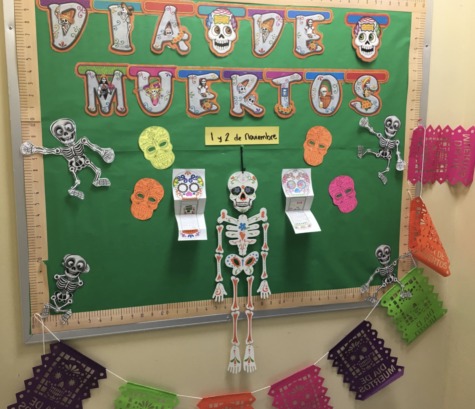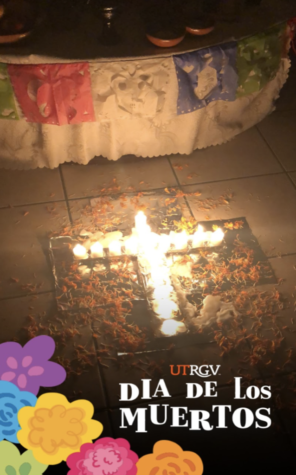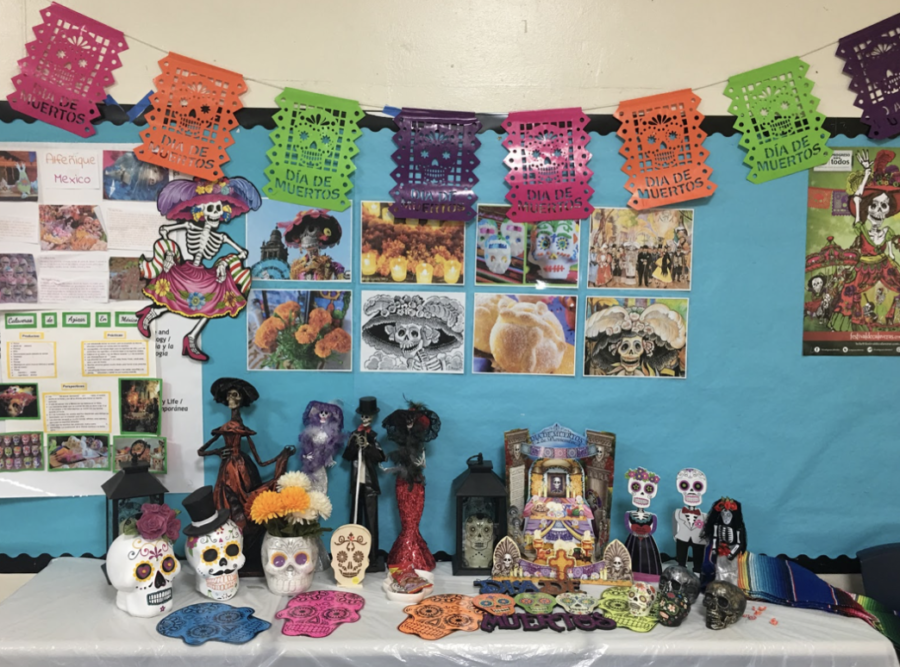Inside Dia de los Muertos
Sra. Gutiérrez’s ofrenda is decorated with calaveras, papel picado, photos of other traditional items, and physical depictions of La Calavera Catrina and El Catrín.
Dia de Los Muertos is a celebration deeply rooted in Mexican tradition that can date back to about 3,000 years ago, the time of the Aztecs. When the Spaniards arrived in Mesoamerica they tried to put an end to this celebration by using the threat of death and burning ofrendas, but it could not be stopped. Despite the Spaniards best efforts, this beautiful celebration has thrived and has spread from southern Mexico to the United States.
This tradition is celebrated for honoring ancestors, staying true to the roots of the first celebration, and remembering loved ones. It is important to remember that this tradition is called a celebration for a reason. It is not a time of scary stories, mourning or sadness and is definitely not a time for fearing death. Instead, true celebrations involve food, flowers, bright colors, aromatic smells, and peace. People celebrate Dia de Los Muertos to peacefully remember and celebrate the lives of loved ones and to accept death in a positive way.
A common misconception about the tradition is that it lasts only one day, but this could not be farther from the truth. The celebration starts on Oct. 28 and ends on Nov. 2. The five-day celebration is spent in prayer and special family time with each day meant to remember deceased loved ones. Families also partake in cooking and ofrenda building. Here, families decorate either graves or tiered structures with pictures filled with the loved one’s favorite things: dishes, flowers, sugar skulls, water, candles and papel picado (elaborate paper designs) with visiting and decorating graveyards. In Mexico, graveyards during this time are not what you see in movies but instead become gardens full of bright orange flowers called cempasuchil in Nahuatl, and marigolds in English.
This celebration is observed not only in Mexico but has been kept alive by Mexicans living elsewhere. Nowadays parades and decorations can be found in abundance during the Halloween season with most of them staying close to traditional customs. Other influences are from the movie industries, like that of Disney and 20th Century Fox who have made the movies like The Book of Life and Coco. The impact of Dia de Los Muertos can also be seen in art exhibitions and parades throughout the United States. Some, however, fear that traditions are being lost and that the celebration is being turned into a more Halloween-type holiday. Because of this, it is important to remember that this celebration is an act of love, peace and honoring the celebration of ancestors.
Below is a collection of how fellow Xavier students and teachers celebrate Dia de los Muertos.
-
Sophomore Ameera Rivas said, “We make an ofrenda in my living room where we pray the rosary and go to mass.”
-
Sophomore Citlali Chimal commented, “Celebrating this day for me and my family is an ongoing tradition. It is an important day to remember our loved ones and celebrate their lives.”
-
Sophomore Victoria Vazquez reflected on the celebration saying, “We make an ofrenda, decorate the house, pray a rosary together and occasionally visit the cemetery.”
-
Xavier Spanish teacher Señor Mark Maresca often connects to friends in Guatemala, saying, “I call my friends in Guatemala because they celebrate it over there too. In Guatemala, people spend time in the cemetery.”
-
Xavier Spanish teacher Señora Alexandra Gutiérrez, reflected on the meaning of the celebration. “I spent a class period talking about the history and about the celebration here in Phoenix. In Mexico, I put a picture of my grandpa, old students that have passed away, and other loved ones who have died. I pray for them and their souls and visit the cemetery. The day has evolved but has always been about remembering the dead. It is a day of happiness and a day full of life.”
-
Xavier Spanish teacher Señora Sandra Galache spoke of her traditions. “I try to focus on the importance of Dia de Los Muertos and I emphasize about the difference between Dia de Los Muertos and Halloween. I talked about what is put on the ofrendas and how the graveyards are decorated. In my house, we celebrate with a small ofrenda decorated with photos, candles, a rosary, other religious figures, and the favorite food of the loved ones.”

A bulletin board outside of Sra. Galache’s classroom decorated with student work, calaveras, and papel picado.





